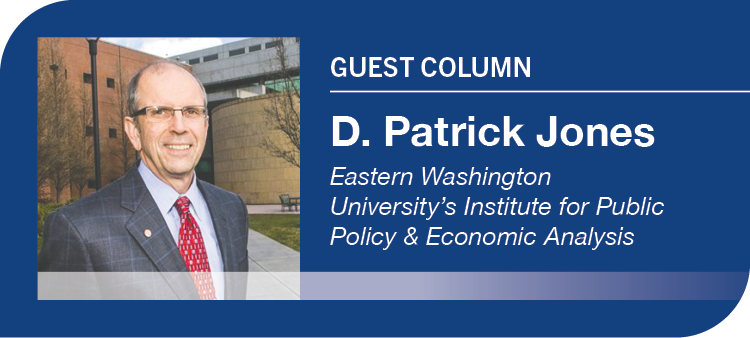
Home » Recent real wage gains haven’t materialized, but 2023 should be different
Recent real wage gains haven’t materialized, but 2023 should be different

October 11, 2023
A glance at key dials on the dashboard of the local economy might conclude that last year was a good one. The population in Benton and Franklin counties registered an increase of about 4,400, with the rate outpacing the state. The number of residents employed grew by about the same – 4,000. Employers in the greater Tri-Cities added even more – 5,100 workers – as the local economy depends on a net inflow of workers from surrounding counties.
Average annual earnings in 2022 grew, too. Or did they?
On a face-value or nominal basis, the average paid to employees of all firms in the two counties climbed by about $1,600. But when measured by the ability to buy goods and services, the average annual wage here actually declined.
Benton-Franklin Trends data gives us this insight. The darker blue line on the accompanying chart is the nominal average wage, coming in for the year at about $61,000 and showing an increase of 2.8% over 2021. The light blue line reveals the number when the inflation is factored in. In that case, the “real” annual wage was $47,865, a decline in inflation-adjusted terms of -4.9%.
As one can see, this is actually the second year in a row where inflation’s bite was larger than the gain in average annual earnings. It might surprise Tri-Citians to learn that this has happened here a few times already. A careful inspection of the graph shows that 2006, 2008, 2011, 2012, 2013 and 2014 all brought falling real earnings of the average worker in the greater Tri-Cities. It also might surprise readers to know that the equivalent trends for the Washington average do not show any year-to-year declines until 2022.
Prior declines in real average annual earnings here cannot be laid at the feet of high inflation rates. For these years, the annual inflation rate, as measured by the national “urban” consumer price index (CPI), was modest, ranging from 1.4% to 3.8%. Rather, annual nominal wage increases were exceedingly modest, ranging from a slight decline (2012) to a 0.1% increase (2006) to the highest gain achieved, 3.5% (2008).

During and since the pandemic, however, this has not been the case. Average annual wage increases have ranged from 2.8% (2022) to 7.2% (2020). Instead, it’s been a surge in inflation over the past two years that has dragged down real earnings. The CPI increases for 2021 and 2022 were 4.7% and 8.0%, respectively. As readers know, these were unprecedented hikes in the prices of goods and services, at least since the 1980s.
As is almost always the case with averages, the recent decline of real wages in the greater Tri-Cities has varied considerably by sector. This is due to a dispersion of nominal wage gains .Online readers can see this via this Trends indicator here.
Among the five largest local sectors, by employment, nominal gains between 2022-21 ranged from a low of retail workers, 0.5%, to a high of health care workers, at 3.7%. None of these matched the 8% jump in the CPI over the two years.
Not surprisingly then, real average annual wages in all five top sectors suffered declines, ranging from a -7% by retail workers to a -4% by government workers (including school district employees). Wage earners in the next three largest sectors, by employment – hospitality, construction and scientific, and professional services – generally fared a bit better but still experienced real earnings loss. For example, workers in scientific and professional services managed to secure “only” a 2% decline real earnings.
And 2023 in the two counties? Wage and earnings data are available for the first quarter, and the results show a reversal of the 2022 experience. Wages have risen faster than the CPI. The increase in overall average earnings hit 9.2% in the first quarter. Inflation during the quarter was 5.8%.
It seems unlikely that local earnings will maintain this torrid expansion throughout the rest of the year. But it certainly seems plausible that by the end of 2023, the annual rate will be at least 5%. And we know that inflation continues to subside. For the second quarter, the year-over-year rate dropped to 4.0%. For the two months of quarter three available, the CPI increase is lower still.
All in all, it is my sense that inflation-adjusted average earnings in the greater Tri-Cities will show an increase for 2023. But the gain won’t be large. And it will not be large enough to compensate for the losses in 2021 and 2022.
D. Patrick Jones is the executive director for Eastern Washington University’s Institute for Public Policy & Economic Analysis. Benton-Franklin Trends, the institute’s project, uses local, state and federal data to measure the local economic, educational and civic life of Benton and Franklin counties.
Taxes Opinion
KEYWORDS october 2023




